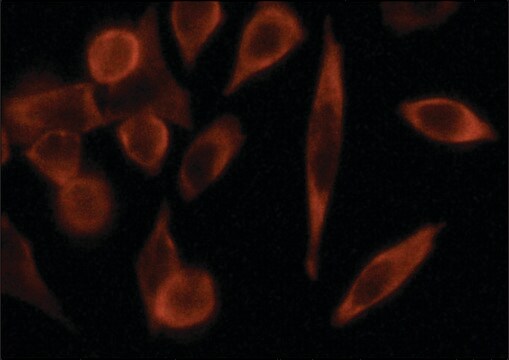MABF125
Anti-TAP1 Antibody, clone mAb 148.3
clone mAb 148.3, from mouse
Synonim(y):
Antigen peptide transporter 1, APT1, ATP-binding cassette sub-family B member 2, Peptide supply factor 1, Peptide transporter PSF1, PSF-1, Peptide transporter TAP1, Peptide transporter involved in antigen processing 1, Really interesting new gene 4 prote
About This Item
Polecane produkty
pochodzenie biologiczne
mouse
Poziom jakości
forma przeciwciała
purified immunoglobulin
rodzaj przeciwciała
primary antibodies
klon
mAb 148.3, monoclonal
reaktywność gatunkowa
human
metody
activity assay: suitable
immunofluorescence: suitable
immunoprecipitation (IP): suitable
western blot: suitable
izotyp
IgG1κ
numer dostępu NCBI
numer dostępu UniProt
Warunki transportu
wet ice
docelowa modyfikacja potranslacyjna
unmodified
informacje o genach
human ... TAP1(6890)
Opis ogólny
Immunogen
Zastosowanie
Western Blotting Analysis: A representative lot from an independent laboratory detected TAP1 in microsomes of baculovirus-infected SF9 cells, which express wild type or select mutations of TAP1 (Chen, M., et al. (2004). J Biol Chem. 279(44):46073-46081.).
Western Blotting Analysis: A representative lot from an independent laboratory detected TAP1 in SF9 cells infected with recombinant baculovirus containing TAP1 gene constructs (Meyer, T. H., et al. (1994). FEBS Lett. 351(3):443-447.).
Immunofluorescence Analysis: A representative lot from an independent laboratory detected TAP1 in HeLa cells contransfected with wild type TAP1 and TAP2 (Hulpke, S., et al. (2012). Cell Mol Life Sci. 69(19):3317-3327.).
Immunofluorescence Analysis: A representative lot from an independent laboratory detected TAP1 in SF9 cells infected with rBV-TAP1/rBV-TAP2 (Meyer, T. H., et al. (1994). FEBS Lett. 351(3):443-447.).
Immunoprecipitation Analysis: A representative lot from an independent laboratory immunoprecipitated TAP1 from SF9 cells infected with rBV-TAP1/rBV-TAP2 (Meyer, T. H., et al. (1994). FEBS Lett. 351(3):443-447.).
Activity Assay Analysis: This antibody inhibits TAP-specific peptide transport (Plewnia, G., et al. (2007). J Mol Biol. 369(1):95-107.).
Jakość
Western Blotting Analysis: 0.5 µg/mL of this antibody detected TAP1 in 10 µg of Interferon-gamma (IFN-g) treated HeLa cell lysate.
Opis wartości docelowych
Postać fizyczna
Inne uwagi
Nie możesz znaleźć właściwego produktu?
Wypróbuj nasz Narzędzie selektora produktów.
Kod klasy składowania
12 - Non Combustible Liquids
Klasa zagrożenia wodnego (WGK)
WGK 2
Temperatura zapłonu (°F)
Not applicable
Temperatura zapłonu (°C)
Not applicable
Certyfikaty analizy (CoA)
Poszukaj Certyfikaty analizy (CoA), wpisując numer partii/serii produktów. Numery serii i partii można znaleźć na etykiecie produktu po słowach „seria” lub „partia”.
Masz już ten produkt?
Dokumenty związane z niedawno zakupionymi produktami zostały zamieszczone w Bibliotece dokumentów.
Nasz zespół naukowców ma doświadczenie we wszystkich obszarach badań, w tym w naukach przyrodniczych, materiałoznawstwie, syntezie chemicznej, chromatografii, analityce i wielu innych dziedzinach.
Skontaktuj się z zespołem ds. pomocy technicznej








